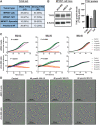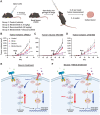MEK Inhibition Synergizes with TYK2 Inhibitors in NF1-Associated Malignant Peripheral Nerve Sheath Tumors
- PMID: 36799629
- PMCID: PMC10102849
- DOI: 10.1158/1078-0432.CCR-22-3722
MEK Inhibition Synergizes with TYK2 Inhibitors in NF1-Associated Malignant Peripheral Nerve Sheath Tumors
Abstract
Purpose: Malignant peripheral nerve sheath tumors (MPNST) are aggressive sarcomas with limited treatment options and poor survival rates. About half of MPNST cases are associated with the neurofibromatosis type 1 (NF1) cancer predisposition syndrome. Overexpression of TYK2 occurs in the majority of MPNST, implicating TYK2 as a therapeutic target.
Experimental design: The effects of pharmacologic TYK2 inhibition on MPNST cell proliferation and survival were examined using IncuCyte live cell assays in vitro, and downstream actions were analyzed using RNA-sequencing (RNA-seq), qPCR arrays, and validation of protein changes with the WES automated Western system. Inhibition of TYK2 alone and in combination with MEK inhibition was evaluated in vivo using both murine and human MPNST cell lines, as well as MPNST PDX.
Results: Pharmacologic inhibition of TYK2 dose-dependently decreased proliferation and induced apoptosis over time. RNA-seq pathway analysis on TYK2 inhibitor-treated MPNST demonstrated decreased expression of cell cycle, mitotic, and glycolysis pathways. TYK2 inhibition resulted in upregulation of the MEK/ERK pathway gene expression, by both RNA-seq and qPCR array, as well as increased pERK1/2 levels by the WES Western system. The compensatory response was tested with dual treatment with TYK2 and MEK inhibitors, which synergistically decreased proliferation and increased apoptosis in vitro. Finally, combination therapy was shown to inhibit growth of MPNST in multiple in vivo models.
Conclusions: These data provide the preclinical rationale for the development of a phase I clinical trial of deucravacitinib and mirdametinib in NF1-assosciated MPNST.
©2023 The Authors; Published by the American Association for Cancer Research.
Figures






References
-
- Wu LMN, Lu QR. Therapeutic targets for malignant peripheral nerve sheath tumors. Future Neurology 2019;14:FNL7.
Publication types
MeSH terms
Substances
Grants and funding
LinkOut - more resources
Full Text Sources
Research Materials
Miscellaneous

